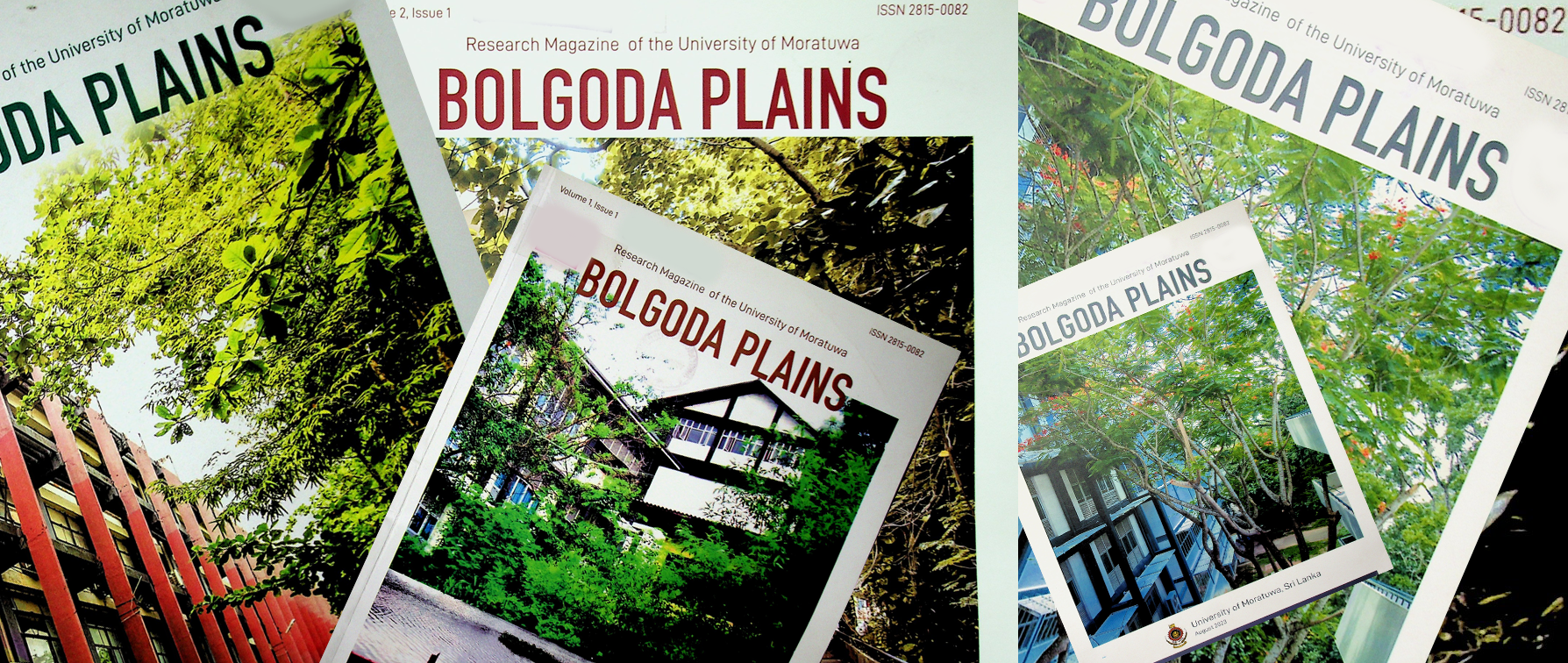Institutional-Repository, University of Moratuwa
Welcome to the University of Moratuwa Digital Repository, which houses postgraduate theses and dissertations, research articles presented at conferences by faculties and departments, university-published journal articles and research publications authored by academic staff. This online repository stores, preserves and distributes the University's scholarly work. This service allows University members to share their research with a larger audience.
 Research Publications |  Thesis & Dissertation |  E- Books |



 UoM Journal Publications |  UoM Conference Proceedings |  Articles published in Scimago's Q1 journals |  UoM Research Reports |  Other Articles authored by UoM staff |
Recent Submissions
item: Conference-Abstract
Development of exhaled breath analyzer
(Department of Materials Science and Engineering, University of Moratuwa, 2024) Samintha, M. M. D.; Thalayarathna, D. R. C.; Attygalle, D.; Sivahar, V.
This study investigates the elevated levels of acetone found in the exhaled breath of diabetic patients compared to healthy individuals. A gas sensor, constructed from Zinc Oxide nanoparticles, will be employed to quantify the acetone concentration in exhaled breath. The research primarily aims to explore the relationship between the material and electrical attributes and the gas sensing performance of Zinc Oxide nanoparticles under UV excitation.
item: Conference-Abstract
Development of low-cost wall panels using waste foundry dust
(Department of Materials Science and Engineering, University of Moratuwa, 2024) De Silva, K. M. D. N.; Jayarathna, M. U. S.; De Silva, G. I. P.; Fernando, T. N.; Sivahar, V.
Waste foundry dust (WFD), a residual material generated by the metal casting industry, presents a significant environmental challenge due to its high volume and current disposal practices, which primarily involve landfilling. This research investigates the potential of WFD as an economically viable construction material for the development of wall panels. The study aims to address the depletion of high-cost and limited natural resources by proposing a substitute material that is both readily available and cost-effective. The research encompasses a comprehensive framework encompassing material selection, processing techniques, and rigorous testing protocols to evaluate the feasibility of incorporating WFD into wall panel production. Performance evaluation will focus on key parameters including flexural strength, thermal conductivity, and water absorptivity, benchmarking against existing wall panel products in the market. Sample 4, composed of a 1:1 ratio of cement and laterite soil, 0.75 foundry dust, and 0.25 biochar, exhibited the highest flexural strength at 4.56 MPa. This sample also demonstrated a thermal conductivity of 0.134 W/mK and a water absorptivity of 21.97%. Through the development of a cost-effective wall panel utilizing WFD, this research endeavors to contribute to the advancement of green building practices within the construction industry.
item: Conference-Abstract
Development of optical property based oil quality analyzer
(Department of Materials Science and Engineering, University of Moratuwa, 2024) Perera, P. S. K.; Bogahawaththa, B. M. S. B.; Attygalle, D.; Sivahar, V.
This article introduces a highly sensitive, rapid and low-cost sensing method for online analysis of engine oil quality and predicts the exact time of oil expiration. The multi-mode optical fiber (MOF) is tapered with great accuracy in measuring the oil refractive index values in engines. In this research, viscosity is considered as the most critical parameter of the engine oil, which contributes to the oil degradation. By comparing the viscosity values of the oil and refractive index values of the oil, the exact quality of the oil is predicted.
item: Conference-Abstract
Development of shape memory polymer nanocomposites for aerospace applications
(Department of Materials Science and Engineering, University of Moratuwa, 2024) De Zoysa, G. W. Y.; Dissanayake, D. M. K. D.; Samarasekara, A. M. P. B.; Sivahar, V.
This study explores the integration and characterization of shape memory composites designed for aerospace engineering, with a focus on Cyanate Ester (CE) as the shape memory polymer (SMP). CE-based SMPs are recognized for their exceptional high-temperature properties, stemming from the Cyanurate network formed during curing, which enhances their resilience in harsh environments. The shape memory properties of CE are further improved by introducing flexible modifiers into its highly crosslinked structure. Cyanate Ester/Polyethylene Glycol (PEG) composites are highlighted as sustainable SMPs for space applications due to their high glass transition temperature, superior mechanical properties, and durability. This work examines how varying PEG content influences the glass transition and curing temperatures. Characterization techniques, including SEM, FTIR, DSC, TGA, and mechanical testing, are employed to evaluate the performance of these composites. The study aims to optimize mechanical strength, thermal stability, and shape memory behavior, advancing the development of aerospace materials for deployable structures, hinges, antennas, and morphing components, particularly in high-temperature environments.
item: Conference-Abstract
Development of sustainable cement based material for additive manufacturing
(Department of Materials Science and Engineering, University of Moratuwa, 2024) Jayananda, D. N. G.; Liyenage, S. H.; De Silva*, G. I. P.; Sivahar, V.
This paper presents experimental results on the optimization of sustainable cement-based mix for additive manufacturing techniques. An extrusion-based 3D Cement Printing (3DCP) machine was modified for the experiment according to the requirement. Cement-based mix was designed and tested for the printing process. A mix design was tested for the fresh properties of the mix: extrudability, flowability, workability, buildability and open time. The printing machine and parameters were enhanced to achieve the required properties of the printing process. The potential of enhancing sustainability of the mix was investigated by reducing the carbon footprint of the process. Supplementary cementitious materials (SCMs) such as fly ash and silica-fume were considered as environmentally friendly materials to add as a portion of binder to the mix. This experiment yielded in mixing fly ash and silica fume to replace conventional binder proportionally, successive in fresh properties. The effect of additives in the cement mic was observed.
